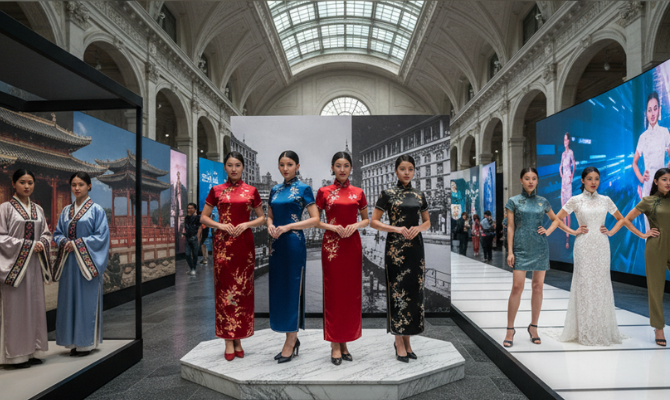
Key Takeaways
The Chinese qipao did not begin as the form-fitting dress we know today; it evolved from the wide, straight-cut Manchu robes (changpao) of the 17th-century Qing Dynasty.
The "Golden Age" of the qipao occurred in 1920s-1940s Shanghai, where it was transformed by Western tailoring into a symbol of modern femininity.
The male equivalent of the qipao is the changshan, a traditional long tunic, answering the query for a chinese qipao men style.
After a period of decline, the qipao was preserved in Hong Kong and Taiwan and experienced a global revival through iconic films and international fashion.
Today, the qipao is both a cherished link to heritage, seen in the chinese qipao wedding tradition, and a versatile fashion piece, as seen in the popular chinese qipao top.
Introduction
The Chinese qipao is more than an iconic qipao dress; it is a living document of China's history. Its silhouette tells a story of imperial dynasties, cultural revolutions, golden ages of cinema, and the rise of a global fashion consciousness. To trace the history of the qipao is to trace the journey of the modern Chinese woman herself.
This article explores that remarkable evolution—from a loose-fitting imperial robe to the glamorous, figure-hugging garment that continues to captivate the world.
The Imperial Origins: Manchu Robes of the Qing Dynasty (1644–1912)
The story of the qipao begins not in Shanghai, but with the Manchu people who founded the Qing Dynasty. The original garment was called the changpao (長袍), or "long robe." It was a wide, straight, A-line robe designed to be worn by both men and women of the Manchu "Banner" system (a social/military structure). In fact, the word "qipao" (旗袍) literally translates to "banner robe."
This early version was modest and practical, concealing the wearer's figure and designed for ease of movement, including for horseback riding. The male version, the changshan (長衫), was the standard formal attire for men and is the historical answer to the chinese qipao men style.
The Golden Age: Shanghai's Roaring Twenties (1920s–1940s)
The qipao as we know it was born in the dynamic, cosmopolitan melting pot of Shanghai in the 1920s. After the fall of the Qing Dynasty, Chinese women sought a modern identity. They adopted the straight-cut changpao but began radically transforming it.
Western Influence: Shanghai's tailors started incorporating Western techniques like darts and set-in sleeves, creating a figure-hugging silhouette that celebrated the female form.
A Symbol of Modernity: This new, tailored modern qipao became the uniform of the modern woman—intellectuals, socialites, and celebrities. It was a declaration of liberation and sophistication.
Stylistic Explosion: The 1930s saw endless innovation: hemlines rose and fell, side slits became daringly high, and new fabrics like printed silks and velvets became popular.
Decline and Preservation (1950s–1980s)
Following the Communist Revolution in 1949, the qipao's fortunes changed dramatically in mainland China. It was condemned as bourgeois and decadent, a symbol of a past era, and it largely disappeared from daily life.
However, the garment's legacy was preserved and continued to flourish in other regions, most notably:
Hong Kong: The qipao became a staple in Hong Kong, immortalized in countless classic films, most famously in director Wong Kar-wai's masterpiece, "In the Mood for Love."
Taiwan and Diaspora Communities: Women in Taiwan and in Chinese communities across the world continued to wear the qipao for formal occasions, keeping the tradition alive.
The Global Revival: From Cinema to Catwalk (1990s–Present)
Beginning in the 1990s, the qipao experienced a powerful resurgence.
Cultural Re-embrace: In mainland China, it was reclaimed as a symbol of national pride and cultural heritage. It is now a popular choice for hostesses, diplomats, and brides.
International Fashion Icon: Global fashion designers began incorporating elements of the qipao—the Mandarin collar, the Pankou knots, the silhouette—into their collections. It moved from a purely cultural garment to a recognized global fashion statement.
Today, the Chinese qipao exists in many forms. The tradition of the chinese qipao wedding is more popular than ever, and the versatile chinese qipao top has become a chic way to incorporate heritage into everyday wear.
For a complete overview of every qipao style, fabric, and design element, be sure to read our comprehensive pillar guide: [The Complete Guide to Qipao: Everything You Need to Know About Chinese Cheongsam Dresses]
Qipao vs. Cheongsam: A Final Clarification
The terms qipao vs cheongsam refer to the same dress. The difference is simply linguistic:
Qipao (旗袍): The Mandarin name.
Cheongsam (長衫): The Cantonese name, which became widely known in the West.
Conclusion: A Dress That Carries History
From a modest Manchu robe to a symbol of Jazz Age liberation and finally to a global icon of elegance, the Chinese qipao has had an extraordinary journey. It is a rare garment that has not only survived history but has been shaped by it, reflecting the trials and triumphs of a nation in every stitch. To wear a qipao is to wear a piece of that magnificent history.
Frequently Asked Questions (FAQ)
Q1: What is the correct qipao pronunciation? The correct pronunciation is "chee-pow." "Qi" sounds like the "chee" in "cheese," and "pao" rhymes with "now."
Q2: Is there a chinese qipao men version? Yes, the traditional male equivalent is the changshan (長衫), a long tunic that shares a common origin with the qipao. Modern designers also create male jackets and shirts with qipao elements like the Mandarin collar and frog knots.
Q3: Why did the qipao become so form-fitting in the 1920s? The transformation was driven by major social changes in the Republic of China. As women gained more freedom and sought a modern identity, they moved away from the old imperial styles that concealed the body. The adoption of Western tailoring techniques in the fashion hub of Shanghai allowed for a new silhouette that was seen as sophisticated, liberated, and modern.
